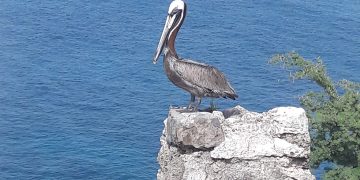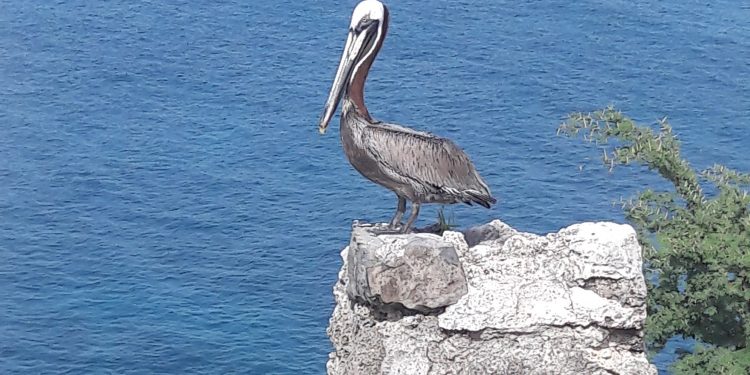PHILIPSBURG, Sint Maarten – In the coming months the Nature Foundation will determine the population status of the Brown Pelican (Pelecanus occidentalis) by conducting pelican counts on several important birding locations around the island. Collecting data about Pelicans is important to provide information about the population and resulting threats in Sint Maarten. The new research results of the national bird will be compared with those of past years, the Foundation already monitors the population since 2010. This research is an important component of the Pelican monitoring project, the annual data is necessary to create a long-term study about St Maarten´s national bird, their health and abundance.
Under the lead of Bachelor student Saskia Werner, who is studying “Environmental Monitoring” at the University of Applied Sciences Dresden located in Germany, information about pelican population data is recorded monthly. The research will unveil the abundance of pelicans living on Sint Maarten through recording the number of adult and juvenile pelicans. Additionally, the number of chicks and nests are recorded and their distribution is being researched.
“In nature it is normal to see fluctuations in population sizes for bird species, which often depends on the predator-prey relationship and always oscillates between a high and lower population size. However, if a dropping population trend continues for a longer time period, our bird population could be threatened and other reasons, such as human influences, could be the cause for their decrease” explained Saskia Werner.
The easiest way to determine the size of population is to count the birds in early morning hours. Based on two different types of counting, the Foundation is possible to record all pelicans and nests in one morning. The monitoring is conducted by remaining still on one location to count the birds, the other method involves a walk around the location while counting all aspects of the pelicans. The latter method gives the opportunity to record all breeding pelicans, nestlings as well as any further colony members and additional information. Around Sint Maarten Day, the Nature Foundation will complete a pelican count on several locations in Sint Maarten to get an overview of the population size on the Dutch side. Recorded data will be scientifically analyzed to determine the status of the national bird, it’s abundance and distribution.
The brown pelican is an important bird species to Sint Maarten, as it is the national bird and is featured on our flag. Pelicans can be found everywhere on the island, especially close to water, such as in the Great Salt Pond in Philipsburg as well as on Fort Amsterdam next to Great Bay and Little Bay. The most important spot for Brown Pelicans on Sint Maarten are the rocks of Fort Amsterdam where most of the breeding colonies are located (Dutch Side). Therefore, Fort Amsterdam is the main location of the Nature Foundation’s pelican research project. Brown pelicans can have a wingspan of over 2m/ 6ft, brown pelican species are the smallest species in the Pelican family and the only ones who dive to catch their prey. Characteristics of this bird include their long bill, up to 30cm long, and the big pouch which can store three times more fish than their stomach.
Photo caption; A beautiful brown Pelican was captured in front of the rocks of Fort Amsterdam, St Maarten, during pelican monitoring activities (photo credit Saskia Werner).


















